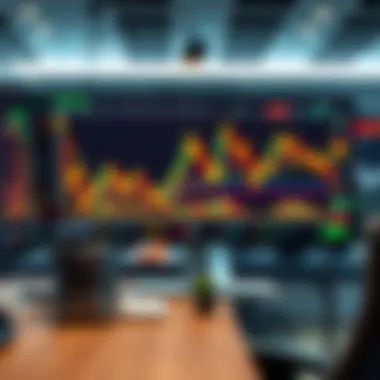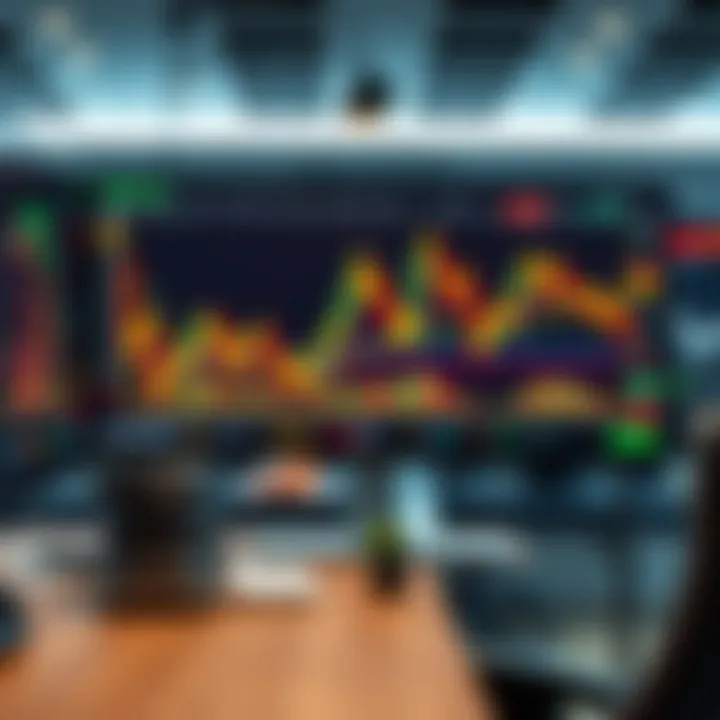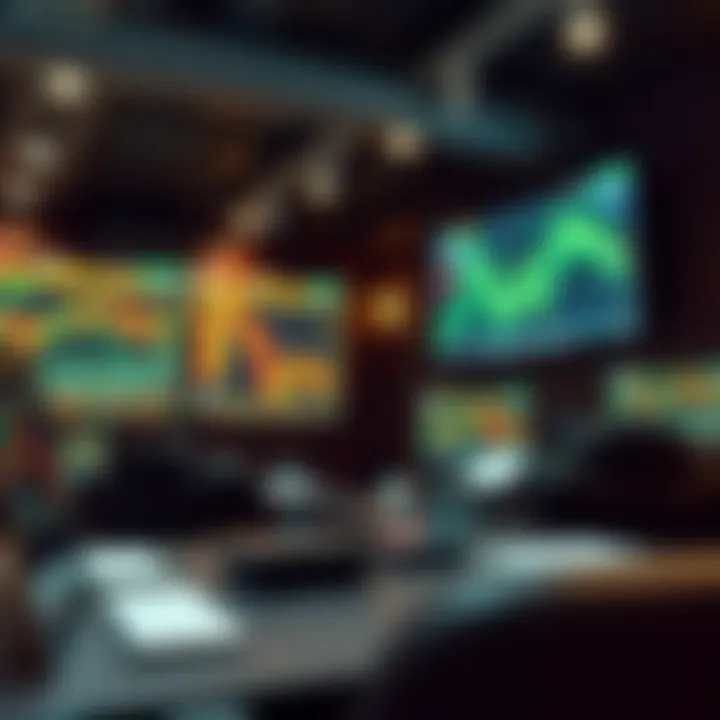Understanding Forex Live Trading Rooms for Traders


Investment Dictionary
Before diving into the intricacies of a Forex live trading room, it is essential to understand some fundamental terms that often crop up in discussions.
Definition of Key Terms
- Forex (Foreign Exchange): The global market for trading currencies. Traders buy and sell currency pairs to profit from fluctuations in exchange rates.
- Pip (Percentage in Point): The smallest price change in a currency pair, indicating a change in value. In most pairs, a pip is one-hundredth of a percent.
- Leverage: A ratio that allows traders to control larger amounts of capital with a smaller amount of their own money. It amplifies both potential profits and risks.
- Spread: The difference between the buying price and the selling price of a currency pair. It indicates the transaction cost incurred by a trader.
- Lot: A standardized quantity of a currency pair in Forex trading. The standard lot is typically 100,000 units of the base currency.
Breakdown of Terminology Usage
When navigating a Forex live trading room, the significance of these terms becomes abundantly clear. For instance, understanding what a pip is can help traders gauge the potential impact of a minor fluctuation on their overall trading strategy. Similarly, grasping the concept of leverage is crucial as it involves considerable risk—some traders may only learn this the hard way when they face significant losses due to over-leveraging their positions.
A mastery of these basic terms not only enhances communication among traders but also contributes to a more profound comprehension of the trading environment. Traders often share tips and terminology in a semi-structured format, enhancing the collective knowledge of the room.
Expert Advice
Navigating the world of Forex trading can be daunting, especially for newcomers, but incorporating expert advice can make a marked difference in your trading success. This section aims to provide two foundational pillars for effective trading strategies and risk management.
Investment Strategies
- Scalping: This strategy involves making numerous trades throughout the day, holding positions for mere minutes or seconds. The objective is to capture small price movements. Scalpers benefit from tight spreads and high leverage since they aim for minimal profit from each trade.
- Swing Trading: Swing traders aim to capture larger price swings over several days or weeks. They typically analyze chart patterns and create positions based on anticipated shifts in market momentum.
- Position Trading: This long-term strategy involves holding onto positions for weeks, months, or even years. Traders who utilize this strategy focus on fundamental analysis, looking at larger economic indicators affecting currencies.
- Day Trading: Involves buying and selling on the same day to capitalize on intra-day price movements. Day traders need to remain glued to the screen, frequently adjusting their positions.
Risk Management Tips
Implementing a solid risk management strategy is vital for any trader. Here are some tips to mitigate risks:
- Set Stop-Loss Orders: Always set a stop-loss to limit potential losses. This method ensures a safeguard against unforeseen market swings.
- Avoid Over-Leveraging: While leverage can amplify profits, it can equally magnify losses. Keeping leverage at a sensible level is essential to maintain a sustainable trading approach.
- Diversify Your Portfolio: Don't put all your eggs in one basket. Trading multiple currency pairs can help mitigate risks associated with specific currencies.
- Regularly Review Your Performance: Keep a trading journal to analyze which strategies are working and which ones need fine-tuning. Learning from your mistakes is crucial.
"The market is a place where you can get rich quickly… unless you don’t know what you’re doing."
By comprehensively understanding essential terminology and employing expert advice, traders—from those feeling like fish out of water to savvy veterans—can optimize their experience within a Forex live trading room.
Understanding Forex Live Trading Rooms
In the labyrinthine world of foreign exchange trading, having a foothold in a Forex live trading room can feel like standing on solid ground. For many, these virtual spaces serve as invaluable catalysts for learning and decision-making. Defined broadly, these trading rooms bring together traders, mentors, and technology in a synchronous environment, fostering real-time analysis and community engagement.
Definition and Purpose
A Forex live trading room is essentially a platform where traders can gather to observe, learn, and execute trades simultaneously with guidance from experienced mentors or analysts. Think of it as a bustling marketplace, but instead of wares, traders exchange insights, strategies, and sometimes, even frustrations about the markets. The primary purpose is twofold: to provide immediate access to market information and to create a collaborative learning environment.
Traders of all skill levels can gain from the dynamic discussions that unfold. Novices learn the ropes by listening to seasoned experts, while experienced traders sharpen their own skills by bouncing ideas off one another.
Key benefits of participating in a Forex live trading room include:
- Real-time insights: The markets are ever-changing, and having access to live commentary keeps traders informed.
- Collaborative learning: Engaging with others allows for exchange of techniques and trading strategies.
- Supportive community: In the sometimes isolating realm of trading, these rooms cultivate a sense of camaraderie.
Historical Background
The concept of Forex live trading rooms isn't something that emerged overnight. In fact, it harkens back to the early 2000s, as trading technology began to evolve. Before this era, trading primarily occurred on the floor of stock exchanges, a lively and chaotic environment. As technology advanced, the shift to online platforms opened avenues for global participation.
At first, online trading was relatively rudimentary, with many traders working in isolation. Over time, like-minded individuals found ways to connect virtually, leading to the establishment of these trading rooms. By incorporating innovations such as live streaming, chat features, and analytical tools, these rooms have transformed into comprehensive educational hubs. The community aspect continues to grow, fostering an environment where learning and trading occur in tandem.
"The advent of online trading platforms reshaped how traders connect and learn, setting the stage for Forex live trading rooms to flourish."
As such, understanding the structure, dynamics, and significance of Forex live trading rooms is crucial not only for aspiring traders but also for seasoned professionals aiming to refine their strategies in a supportive setting.
The Structure of a Forex Live Trading Room
Understanding the structure of a Forex live trading room is essential for grasping how these environments both stimulate and support effective trading practices. This structure encompasses various elements that contribute not just to individual trader success but also to collective learning and collaboration. The layout, functioning, and integration of different roles within a trading room can significantly enhance both the learning experience and trading outcomes.
Key Components
Traders
The primary stakeholders in a Forex live trading room are the traders themselves. They bring a diverse range of experiences and perspectives that enrich discussions and decision-making. One key characteristic of traders is their adaptability; they navigate market shifts with agility, responding to rapid changes with well-thought methods. This adaptability is crucial, as it promotes a dynamic environment where every trader brings something unique to the table.
Traders' diverse backgrounds often lead to innovative strategies that might not be commonly encountered in traditional educator-led sessions. However, participation can have its challenges.
For example, a trader might feel overwhelmed in a bustling room filled with sharp minds. This underscores the importance of cultivating a supportive culture that allows each trader to share insights without feeling overshadowed. Ultimately, the presence of varied perspectives creates a vibrant educational environment, promoting growth not just in skill, but in confidence as well.
Mentors
Mentors play a pivotal role in Forex live trading rooms, guiding traders through complex market terrains. The expertise they possess is foundational; they not only teach strategies but also instill a mindset geared toward smart trading decisions. A hallmark of effective mentors is their ability to simplify complex concepts, making them more accessible, especially for inexperienced traders.
Mentors provide invaluable feedback, enhancing the educational experience by addressing mistakes in real time and encouraging reflective thought. However, there’s a downside; not all mentors may resonate with every trader.
A mentor's approach may work wonders for some, but not for those with different learning styles. Identifying the right mentor can be as important as obtaining the knowledge itself. Finding a mentor who matches a trader's cultural context and personal approach must be a strategic choice.


Technological Tools
Technological tools are the backbone of Forex live trading rooms, providing the necessary infrastructure for real-time trading and analysis. Key tools include advanced charting software, multiple market analysis platforms, and integrated communication systems that facilitate collaboration. The most effective tools offer user-friendly interfaces while ensuring access to powerful features like predictive analytics, which help traders make informed decisions quickly.
Additionally, the integration of various technological tools ensures that all participants can engage seamlessly, regardless of their technical proficiency. Yet, these tools can pose a challenge if traders become too reliant on technology, potentially failing to develop the intuition necessary to read markets without artificial aids. Balancing technical reliance with personal judgment is crucial.
Typical Workflow
In terms of workflow, a Forex live trading room is typically characterized by a structured series of events that keep traders engaged and informed. The process starts with an analysis of pre-market conditions, followed by the live trading session where strategies are implemented, and wraps up with reflection and review sessions. This structured workflow serves to maintain focus and encourages traders to remain proactive.
Overall, the robustness of the structure within a Forex live trading room is a significant factor in shaping the trading experience. Elements such as traders' diversity, the knowledgeable presence of mentors, and the effectiveness of technological tools all contribute to a dynamic and enriching environment where trading can thrive.
Benefits of Participating in a Forex Live Trading Room
Participating in a Forex live trading room can significantly alter a trader's approach to the market. The reasons for this are manifold, leading to enhanced skills, improved results, and an overall better grasp of trading dynamics. Especially for those navigating the tumultuous waters of currency trading, these environments offer a wealth of benefits that can catapult one’s trading journey to new heights.
Real-Time Insights and Analysis
One of the most compelling advantages of being in a Forex live trading room is access to real-time insights and analysis. When traders share their thoughts and strategies live, it creates a rich tapestry of information that can be invaluable. This immediacy means that participants can react to market movements as they occur, rather than relying on outdated data or post-factum insights.
- Access to expert commentary from experienced traders who can analyze trends and point out potential opportunities.
- The ability to observe and mimic trading styles, reaction times, and strategies in real-time.
- Instant feedback on trades, helping to refine personal strategies more rapidly.
This blend of real-time information allows traders to adapt their methods on-the-fly, potentially improving profit margins while minimizing losses. Analytics tools and charting software, which are essential in live trading rooms, also enable participants to observe market behavior dynamically, fostering a deeper understanding of market mechanics.
Collaborative Learning Environment
In a live trading room, collaboration thrives. This aspect of learning is unique; participants aren’t just passive observers but active contributors who learn from each other’s successes and failures alike. Traders at various skill levels contribute different perspectives and insights, which cultivates a rich learning ambiance.
- Engaging discussions that delve into trading approaches, specific market events, or strategies lead to a shared knowledge base.
- Participants can ask questions, receive real-time answers, and clarify doubts with mentors and peers, fostering faster learning curves especially for novice traders.
- This camaraderie can lead to shared accountability, which encourages consistent engagement and practice.
Moreover, this social aspect of trading can enhance a participant's psychological resilience. Trading can often feel isolating, and being part of a community allows for emotional support, shared experiences, and motivation to keep pushing through challenging times.
Networking Opportunities
Lastly, the networking potential in a Forex live trading room is a gold mine. Beyond learning and growth, the relationships built here can lead to fruitful alliances in trading and investment.
- Connections with experienced traders can provide mentorship opportunities that can accelerate one's trading proficiency.
- Building relationships with peers might lead to partnerships in trading strategies, collective investments, or sharing of valuable resources.
- This networking can also serve future professional opportunities within the financial sector, where many traders find their footing through connections made in such rooms.
In summary, participating in a Forex live trading room offers a myriad of benefits that range from heightened market understanding to forging invaluable connections. This kind of environment not only enhances the quality of trading but also helps in establishing a solid foundation for a trading career that can evolve as the market does.
Essential Tools and Features
In the fast-paced world of forex trading, relying solely on instinct or outdated information just doesn’t cut it. Engaging in a Forex live trading room enriches traders' experiences through a variety of essential tools and features. These components serve not only to streamline the trading process but also to augment traders' abilities to grasp market trends accurately, make informed decisions quickly, and collaborate effectively with other participants. Keeping this in mind, let’s delve deeper into some crucial tools that facilitate a productive trading environment.
Charting Software
Charting software stands as the backbone of technical analysis in forex trading rooms. This tool provides traders with visual representations of price movements, helping them identify patterns and potential trading opportunities. Think about it—trying to make sense of market trends without a chart is like trying to navigate a maze blindfolded.
Key aspects of charting software include:
- Real-time data: Streamlined updates ensure that traders are informed of price actions without delay.
- Customizable indicators: Traders can tailor their charts with various indicators like moving averages, Bollinger Bands, and RSI, allowing for personalized analysis that suits individual trading styles.
- User-friendly interfaces: Unlike some archaic systems, modern charting platforms are designed with simplicity in mind, welcoming both beginners and seasoned pros alike.
The right charting software can drastically enhance how a trader interprets market dynamics, making it a non-negotiable asset in any live trading room.
Communication Platforms
Effective communication is the lifeblood of a Forex live trading room. With so many minds analyzing the same data, collaboration can lead to innovative trading strategies and insights that one might miss alone. Let’s break it down further—
Chat Rooms
Chat rooms are pivotal components of any Forex live trading setup. They allow traders to share immediate observations and analyses. Picture a bustling café where traders are bouncing ideas off each other; that’s how chat rooms feel.
A key characteristic of chat rooms is their instantaneity. Traders can send messages in real-time, allowing for swift exchanges on market updates or trading strategies. This feature makes chat rooms a particularly beneficial choice for those looking to bounce ideas off others or get real-time feedback.
However, there are a few pitfalls to consider. For instance, the abundance of messages can lead to information overload. Traders need to practice discernment when interpreting chat discussions.
Advantages include:
- Immediate feedback on market moves.
- Community support and shared learning experiences.
Disadvantages may consist of:
- Overwhelming volume of communication.
- Possible noise and distractions that stray from focus.
Video Conferencing
When it comes to sharing insights visually, video conferencing tools outshine text chats. Face-to-face interactions—albeit virtual—add a layer of connection that text simply cannot replace. Video conferencing becomes particularly important during group analysis sessions, where discussing complex strategies becomes more efficient with visual aids.
The main draw of video conferencing lies in its interactive nature. Traders can present their analyses using visual aids, like charts and indicators, that enhance understanding. Participants can ask questions on the spot, thus deepening knowledge and encouraging discussion.


One unique feature of these platforms is the ability for screen sharing. This allows traders to walk others through their thought processes in real-time, making collaborative learning more effective than ever.
Advantages of using video conferencing include:
- Enhanced communication clarity.
- Opportunity for real-time collaborative decision making.
However, there are drawbacks, like:
- Technical glitches that can interrupt sessions.
- The need for a stable internet connection, as poor connectivity can hinder the trading experience.
Market Analysis Tools
Lastly, market analysis tools are essential for every trader aiming to stay ahead of the curve. These tools encompass a variety of resources, from economic calendars to sentiment analysis indicators. Having access to such instruments enables traders to evaluate both fundamental and technical data, leading to more comprehensive trading strategies.
For instance, knowing when key economic reports will be released can help traders brace for volatility, while sentiment analysis can provide insights into how others in the market are thinking, allowing for a more rounded understanding of the trading landscape.
In short, integrating these tools within a Forex live trading room creates a more dynamic, informed trading environment that can significantly boost a trader's effectiveness.
Developing Trading Strategies
Crafting effective trading strategies is a cornerstone of achieving success in the realm of forex trading. This section delves into the vital aspects of developing sound trading strategies within a Forex live trading room, addressing how they can tremendously enhance a trader’s approach to the market. A robust strategy not only guides traders in recognizing entry and exit points but also stirs confidence in their decisions amidst market fluctuations.
Analyzing Market Trends
Understanding market trends is the backbone of any effective trading strategy. It involves scrutinizing historical data and current price movements to predict future behavior in foreign exchange markets. By identifying whether a currency pair is in a bullish or bearish trend, traders can tailor their strategies accordingly.
For instance, if the euro is gaining strength against the dollar over several days, a trader might decide to buy Euros while selling dollars. Tools such as moving averages, trend lines, and chart patterns become indispensable in this process. They enable traders to visualize trends clearly, making it easier to decide when to jump into the market or pull back.
Furthermore, participating in live trading rooms lends an edge in this area. Traders can share insights and discuss trends in real time, benefiting from collaborative analysis. It’s not uncommon for seasoned traders in the room to point out trends that might escape a less experienced eye, enriching the collective understanding of the market.
Risk Management Techniques
Risk management is crucial for safeguarding one's capital in forex trading. It involves establishing rules to minimize losses while maximizing potential gains. This is especially important in a forex live trading room, where rapid decisions can lead to substantial gains or swift losses.
Traders should consider tactics like:
- Setting Stop-Loss Orders: Automatically exit a position when the market moves unfavorably. This helps limit losses without needing constant monitoring.
- Position Sizing: Determine the amount of capital to risk on each trade based on personal risk tolerance. Calculating the appropriate position size is vital to prevent overexposure in volatile markets.
- Diversification: Spread investments across various currency pairs to mitigate risks. A well-rounded approach can cushion against adverse market movements.
“In trading and investing, what is comfortable is rarely profitable.”
By applying these techniques, traders engage with the market in a more controlled manner. Live trading rooms provide a platform for discussing risk management strategies, allowing traders to learn from each other's experiences and adjust their approaches.
Consolidating insights gained from market trend analysis along with practical risk management tactics can lead to the establishment of a comprehensive trading strategy. This approach not only empowers traders but also fosters an environment where informed decision-making is the norm, rather than the exception. As traders refine their strategies, their confidence grows—a key ingredient for long-term success in the dynamic world of forex trading.
Factors Influencing Forex Trading Decisions
In the fast-paced world of Forex trading, decisions need to be sharp and well-informed. Here, we explore the elements that shape the choices traders make, highlighting the critical roles that economic indicators, intraday news, and global events play in influencing trading strategies.
Economic Indicators
Economic indicators are like the weather forecasts we follow: always changing and often indicating how markets might behave. By analyzing these indicators, traders can make educated predictions about currency fluctuations.
Interest Rates
Interest rates are foundational in Forex trading. Simply put, they affect how attractive a currency is to investors. When central banks adjust interest rates, for example, a hike often leads to a stronger currency because higher returns draw in foreign investment. This characteristic makes interest rates a vital marker for traders.
One unique feature is that interest rates can change rapidly with economic conditions, catching many off-guard. The advantage here is clear: traders who keep a close eye on these changes can position themselves favorably before the markets react. However, a disadvantage lies in the complexity of understanding monetary policy—not all traders grasp the causes and implications of these shifts., leading to miscalculations.
Intraday News
Intraday news can be likened to the gossip that travels through a small town. As news filters in real-time, it can dramatically sway trader sentiment and impact prices. Breaking news about economic announcements, political developments, or natural disasters can trigger sharp price movements.
Many traders rely on this news to make split-second decisions, so its importance can hardly be overstated. It’s beneficial for its immediacy; however, it also fosters a fast-moving environment where the wrong interpretation can lead to losses before the dust settles. The key here is to filter out noise from actionable news—and that takes practice and experience.
Global Events and Impact
Global events are like the heavyweights of the Forex arena. They can swing markets in unpredictable ways. A country’s political stability, international trade agreements, and even large-scale events such as pandemics or wars shape traders' sentiments.
Understanding the implications of these events is crucial. For example, the onset of a conflict can cause a flight to safety that benefits currencies like the US dollar, while more stable economies experience sharp downturns. Thus, savvy traders constantly monitor global happenings to stay one step ahead.
In summary, grasping the factors influencing Forex trading decisions isn't merely an academic exercise. It’s a necessity for anyone looking to navigate the turbulent seas of the currency exchange landscape.
Maximizing Value from a Forex Live Trading Room
In today’s fast-paced financial arena, leveraging a Forex live trading room can be more than just a luxury; it can be a game-changer for traders. Whether you are just dipping your toes in the market or have navigated its waters for years, maximizing the benefits of these trading platforms is crucial for success. This section dives deep into specific elements that can help participants get the most out of their experience in a live trading room, emphasizing the significance of personal goals and active participation techniques.
Setting Personal Goals


Before entering a live trading environment, it’s essential to have clear and achievable personal goals. Think of these goals as your compass, guiding you through the often tumultuous waters of Forex trading. They help to define what you want to achieve, whether it be increasing your profit margins, honing your analytical skills, or mastering a specific trading strategy. Making sure your goals are specific, measurable, attainable, relevant, and time-bound—commonly known as SMART goals—can serve as a powerful framework.
For instance, a trader might set a goal to improve their risk management skills. This could involve dedicating a certain number of hours each week to studying various risk assessment techniques or practicing them in a simulated environment before implementing them in real time. It’s not just about the end result; the journey is just as important.
Also, keeping accountability in mind is fundamental. Many live trading rooms incorporate check-ins or progress reports among members, often making it easier to stick to your goals while receiving valuable feedback from peers or mentors. This community aspect transforms solitary trading into a college-like experience where mutual growth occurs. So, before you jump into the trading frenzy, take a moment to reflect on what you really wish to achieve.
Active Participation Techniques
Active participation can significantly elevate your trading experience in a live Forex trading room. The more you engage, the more you learn. Techniques to enhance participation include the following:
- Asking Questions: Don’t hesitate to voice your queries during trading sessions. It’s often said that there’s no such thing as a dumb question in the trading world. Whether it’s a technical analysis question or an inquiry about market trends, engaging others can yield insights that may not be readily available from textbooks.
- Sharing Experiences: Every trader has a unique story. Sharing your own successes and failures not only helps build camaraderie but also fosters a culture of shared learning. Traders can pick up valuable lessons from each other’s experiences, often leading to improved strategies and techniques.
- Utilizing Real-Time Tools: When in a live trading room, make full use of available tools like chat functions, screen-sharing features, and analytical dashboards. These resources are designed to facilitate communication and collaboration and can provide crucial market insights at critical times.
By employing these techniques, the learning experience is enriched. It’s not simply about observing; instead, it’s about being an active player in the scene. The more effort you put into your participation, the greater the potential payoff in terms of skills and knowledge.
"The only stupid question is the one that’s never asked." This adage holds true in Forex trading rooms where sharing and inquiry pave the road to success.
For further insights into effective trading strategies and market analysis techniques, consider visiting resources like Investopedia and NerdWallet. These platforms can supplement your learning and help fuse your personal objectives with actionable results.
Challenges in Forex Live Trading Rooms
Participating in a Forex live trading room can be an exhilarating experience, yet it’s not all smooth sailing. These rooms bring together traders from various corners of the globe, creating a vibrant space for learning and growth. However, it’s crucial to recognize the challenges that accompany this dynamic environment. Identifying and understanding these hurdles is necessary for anyone serious about mastering forex trading in a live setting.
Information Overload
One of the most pressing issues traders face in a live trading room is information overload. When a multitude of opinions, insights, and data flood in at once, it’s easy to become overwhelmed.
- Volume of Data: The sheer volume of charts, market news, and analytical commentary can be daunting. Traders may find it difficult to stay focused on their strategies amid a flurry of conflicting reports and analyses.
- Quality vs. Quantity: Not all information shared in these rooms is created equal. Some traders may present opinions or analyses that lack substance or reliability, leading novices to chase after misleading insights rather than sticking to proven strategies.
- Decision Paralysis: When faced with an abundance of information, traders might fall into the trap of decision paralysis. They contemplate every possible angle without taking action, which can be detrimental in the fast-paced world of forex trading.
To combat information overload, traders should establish a filter. Focus on credible sources and mentors whose insights have proven beneficial. Setting specific trading goals can also help narrow the focus and reduce distractions.
"Sifting through all that noise can feel like trying to find a needle in a haystack. Narrow your focus, and don’t let the chatter cloud your judgment."
Market Volatility
Another formidable challenge in a Forex live trading room is market volatility. The forex market can experience rapid fluctuations due to a variety of factors, which can leave even the most seasoned traders reeling.
- Unexpected Changes: Economic news releases, geopolitical events, and central bank announcements can trigger swift price movements that may not align with existing analyses.
- Emotional Responses: High volatility often leads to heightened emotional responses from traders. Fear and greed can cloud judgment and lead to impulsive trading decisions, which might stray from a trader's strategic plan.
- Risk Management: Navigating through volatile conditions requires adept risk management. Traders must ensure their strategies are robust enough to protect their capital while still enabling them to capitalize on potential short-lived opportunities.
To manage the challenges posed by market volatility, it's essential to have a solid trading plan in place, incorporating protective stops and take-profit orders. Consistent evaluation of one's psychological response to choppy markets can also aid in making level-headed decisions.
In essence, while Forex live trading rooms offer a unique opportunity for collaboration and real-time insight, riders must remain vigilant to the challenges presented by both information overload and market volatility. Self-awareness and discipline can make a significant difference in maximizing one’s trading experience.
Case Studies and Success Stories
Examining case studies and success stories within Forex live trading rooms provides a wealth of practical insights. These examples not only highlight effective trading strategies but also demonstrate the resilience and adaptability of traders. For beginners, such narratives can serve as a beacon in uncharted waters, while seasoned investors can refine their current strategies by identifying common patterns and tactics that lead to successful trades.
Profiles of Successful Traders
Profiles of successful traders often reveal diverse paths and methods used to achieve profitability in the Forex market. Take, for instance, Maria Johnson, a trader who transitioned from an unrelated career in teaching to Forex trading. After struggling initially, she embraced the collaborative aspect of live trading rooms. Maria found mentor figures who guided her through critical learning periods. By participating actively and absorbing diverse viewpoints during discussions, she solidified her understanding of market mechanics. Such profiles underscore that success is not an isolated incident; it is built on learning from others and adapting tools and strategies to one’s unique trading style.
"Success in trading doesn't come overnight, but a good support system makes a world of difference." - Maria Johnson
Similar stories can be found with many traders who have utilized Forex live trading rooms. A trader like Leonard Torres showcases another angle; he earned a sustainable income by focusing on currency pairs that many overlook, thus finding opportunities amid the noise. Leonard's journey highlights the importance of persistence and innovation. Many successful traders emphasize maintaining a growth mindset and engaging in continuous learning to refine their strategies.
Lessons Learned from Setbacks
Every trader’s journey includes setbacks, which can be invaluable in honing skills. These experiences teach critical lessons; after all, in Forex trading, failure often precedes success. Take Simone Harris, a retail trader whose first major trading decision led to significant losses. Initially devastated, she sought out a Forex live trading room for help and found that sharing failures is just as crucial as sharing successes. This community provided her with insights into risk management techniques and helped her create a safety net for future trades.
In some cases, seasoned professionals reflect on earlier mistakes, detailing how irrational trading fueled by emotional responses resulted in poor decisions. They emphasize the importance of maintaining trading discipline and sticking to researched strategies rather than succumbing to impulsive actions.
Future Trends in Forex Live Trading Rooms
The forex market is never static, and neither are the environments in which traders operate. Future trends in Forex live trading rooms not only reflect shifts in technology but also suggest changes in how traders communicate, learn, and ultimately, how they perform. With the world becoming increasingly intertwined and information flowing faster than the blink of an eye, staying on top of emerging trends becomes critical for both new and seasoned traders alike.
Influence of Technology
Technology has revolutionized every facet of life, and Forex trading is no exception. Platforms now provide real-time data analysis and interactive charts that allow traders to make decisions at lightning speed. Think of the move from stationary computers to mobile apps. Now, a trader can engage with their Forex live trading room from anywhere, which is quite different from the days when you had to be tethered to your desk.
There are several notable advancements on the tech front:
- Artificial Intelligence: Many trading rooms are integrating AI tools that analyze past trading patterns. These tools can suggest entry and exit points based on historical data.
- Algorithmic Trading: More traders are employing algorithms to execute trades automatically based on predetermined criteria. This trend adds speed and accuracy to trading,
- Enhanced Communication Tools: Platforms leverage tools like Discord or Zoom, making interaction smoother. It’s not just about sending messages anymore; traders can share screens and work through setups together.
With this technological boom, downsides arise too, like the need for constant updates to keep pace with new software. The challenge here is that not all traders are tech-savvy, and some might find themselves left behind in the dust of innovation.
"In Forex trading, staying connected is as important as being informed. Technology isn't just nice to have—it's a necessity."
Evolving Educational Methods
The landscape of trading education is changing straight out of necessity. No longer can one rely on printed guides and boring webinars. The advent of video content, mentorship from experienced traders in real-time, and even gamified learning are redefining this field. Traders of all levels can now learn visually, which suits many better than traditional methods. Here are a few key developments:
- Interactive Courses: Live trading rooms often host courses that allow participants to learn during actual market hours. This hands-on approach enables traders to see theory put into practice.
- Peer Feedback: Participants can deliver insights to one another, allowing a community-based review of trades rather than just top-down learning from a single mentor.
- Use of Data Visualizations: Education has become more graphic. Visuals clarify complex data, providing a better understanding of market movements and trends.
In this evolving environment, understanding how to grasp new information quickly becomes crucial. Those who can adapt to novel teaching methods will undoubtedly gain an edge, ensuring that both novice and professional traders can thrive in the rapidly shifting market.
As trends continue to unfold, future Forex live trading rooms will likely adapt further, building on these technological advancements and innovative methods to meet the growing demands of traders everywhere.



